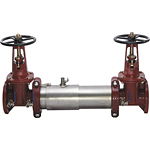
A reduced pressure backflow preventer, also known as a reduced pressure zone device or a rpz device, is a backfow preventer which, as its name suggests, protects you from your water supply being contaminated by backflow. There are several types of reduced pressure backflow preventers including a reduced pressure back flow valve, a double check valve assembly, a pressure vacuum breaker, a reduced pressure detector assembly, a reduced pressure detector assembly Type II, a double check detector assembly and a spill resistant vacuum breaker.
All have resilient seated isolation/shut-off valves and properly located test ports, and they have the advantage of being in-line serviceable and can be tested and repaired without going to the trouble of removing the entire assembly.
A RPZD, or reduced pressure zone device, is considered adequate for significant hazard applications, situation where if backflow were to get into the water supply, significant harm could happen to the public. They prevent both back-pressure and back-siphonage with their redundant design.
These devices consist of two independent check valves with a pressure monitored chamber between the two valves. The pressure is maintained at a pressure lower than the water supply pressure but high enough to be useful downstream, and that pressure is guaranteed by a differential pressure relief valves. In other words, it is a matter of check, double-check and check again, as these mechanisms are continually monitoring the pressure, adjusting the pressure, and making sure water and waste flow in the proper direction.
Does backflow happen often? More often than you would want to know, and the only thing protecting the potable water supply from contamination (human waste) is the proper operation of a reduced pressure backflow preventer or some other variation of a backflow prevention device. The only reason most homeowners are not aware of this potential hazard is because these backflow devices work so well.
In the UK, Illinois, New York, Texas, Missouri and several other states, backflow testing is required every twelve months, and that testing must be conducted by a licensed and accredited backflow testing company. In many locales now, not only are you required to do testing by federal law but also by state and local law.
In Texas, the name to remember is City Backflow Testing. City Backflow Testing offers affordable backflow testing backed by years of experience in installing, inspecting and repairing all backflow devices. When the protection of your water supply is at stake, don’t you think you should go with the very best in backflow testing?

